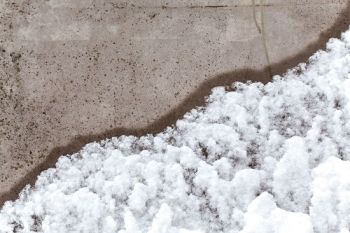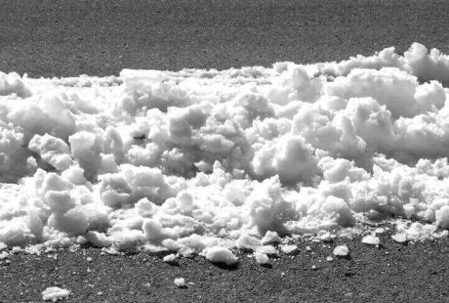What Is Air Entrained Concrete?
Air entrainment sounds like a complicated and intricate term. But actually, it is simply a creation of minute air bubbles in the concrete. Air entrainment can be done at a batch plant or manually by a worker on site.
The science behind the process is pretty straightforward, but it plays a major role in increasing the workability of the concrete in a plastic state as well as its durability when it’s already hardened. On the other hand, concrete is one of the trickiest and most demanding materials in the world. It is hard to mix, pour, smooth over, and finish.
Moreover, working with concrete is quite costly. Especially, when it comes to making mistakes and fixing them. But even if you managed to place the material perfectly, all your efforts can go to waste in the winter; therefore it is very important to take your climate into the account when you are dealing with concrete.
What Causes Freeze-Thaw Damage in Concrete?

Concrete is a fair-weather friend, which means that it has a low tolerance for excessive moisture and sub-zero temperatures. Though concrete appears completely solid, it contains microscopic pores. This is due to the water needed to create the mix.
The minimal water-to-cement ratio is approximately 0.25, which means that there are 25 parts of H2O for every 100 parts of cement. Any extra water may be used to increase the plasticity of concrete.
Eventually, it will dry and leave small capillaries in its place. When it rains or snows, moisture fills these voids. Later on, if the temperatures fall below zero, this liquid will freeze, expanding and creating tiny cracks in the concrete.
The ice will ultimately melt, but gaps in the material won’t go away. Moreover, they will further widen after the next cycle of freeze-thaw; which can lead to permanent damage and cause big chunks of concrete to break off.
Also, if moisture reaches the reinforcing steel, it will rust and expand creating even more cavities and subsequently more pathways for the environmental water.
How Does Air Entraining Work?
Fortunately, scientists came up with air-entraining technology to beat the effects of the freeze-thaw. During the mixing process, constructors add special agents containing a type of detergent to the paste. They create air bubbles inside the concrete.
Their size can vary from 10 to 500 micrometers in diameter. The air pockets are spaced very closely and act as “ball bearings”. Bubbles compress when ice forms. They relieve the stress on the material, acting as chambers for expansion. To achieve such results air bubbles should have a distance of less than 0.25 mm between them.
What Are the Benefits of Air-Entrained Concrete?
The benefits of air-entrained concrete are:
- Frost resilient
- Stress alleviating
- Crack preventative
- Resistant to sulfate and deicing chemicals
- Durable
- Higher workability
- Abrasion resistant
Air Entraining Agents
The technology of adding air bubbles to concrete paste was first used in roadmaking in the 1930s. At that time, construction workers applied Vinsol resin as an admixture. But a lot has changed since then.
Nowadays there are three main types of modern air-entraining agents:
- Fats and oils (both animal and vegetable) and fatty acids
- Wood resins
- Alkali salts of sulfate and sulfonated organic compounds
The Whipped Cream Effect
The workability of the concrete is measured by a slump test that is performed on the construction site in order to check the mixture and make the necessary adjustments. To carry out a slump test you need to take a metal cone and fill it with concrete in four even layers. Each layer should be stroked 25 times with a tamping rod to make sure it is even.
After you finish stuffing the concrete, immediately raise the cone slowly and very carefully. Then you need to measure the difference between the height of the concrete and the height of the cone mold. A slump of about 3 inches is considered to be good. However, air entraining causes the whipped cream effect, reducing the slump by 1-2 inches.
Yet the workability stays the same. Thus, air entraining can also be used to reduce the ratio of water to cement and therefore increase the strength of the concrete.
What to Keep in Mind
Though using air entrainment helps to eliminate the negative freeze-thaw effect, you need to remember that the more air you add, the more the concrete strength will decrease. The average amount of air in the paste should be 4-7%, depending on the climate pattern.
Take into account that some air may be lost during transportation, so if you plan to mix it at the batch plant, make some allowance to compensate. Air entrainment also reduces the shelf-life of concrete.
Where Should You Apply Air-Entrained Concrete?
The positive properties of air-entrained concrete are best utilized in dams, bridges, tunnels, and road construction in countries with harsh winters-such as the USA, Canada, Finland, Estonia, Iceland, Greenland, Mongolia, Russia, Kazakhstan, and many others.
In need of long-lasting concrete services in Baltimore? Our team at Mid Atlantic Asphalt specializes in concrete repair, leveling, maintenance, and installation. To get started, give us a call at (410) 999-1263 or contact us online today!

